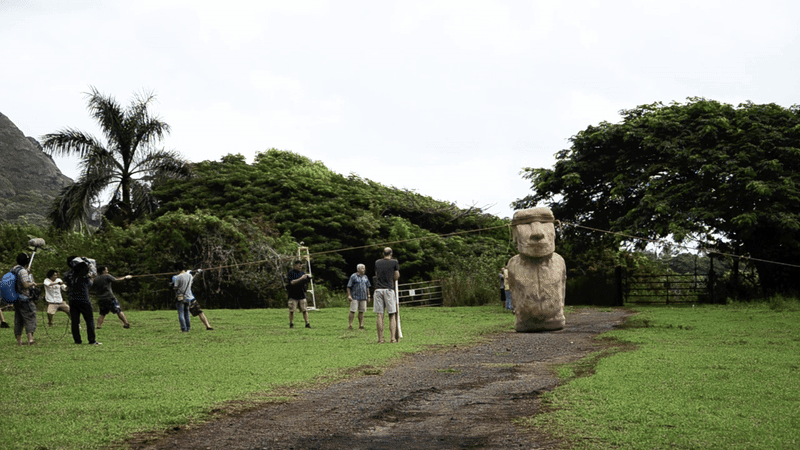Science
Easter Island’s Moai Statues Could Have “Walked” with Simple Techniques

Recent research suggests that the remarkable moai statues of Easter Island could have been moved using a method akin to “walking,” with the help of simple tools, a small group of people, and the principles of pendulum dynamics. This study provides new insights into how the Indigenous people of Easter Island, known as Rapa Nui, transported these monumental statues, which can weigh several tons, across the island centuries ago.
The findings, published in the November 2025 issue of the Journal of Archaeological Science, stem from a detailed examination of incomplete moai statues that were abandoned shortly after being quarried. Researchers noted that many of these statues were intentionally crafted with a low center of mass and a forward tilt, which would have facilitated their transport. Co-author of the study, Carl Lipo, a professor of anthropology at Binghamton University, emphasized the ingenuity behind this method, stating, “What we found is the fact that statues were moved with very small numbers of people in an amazingly ingenious way.”
Innovative Transport Techniques Unveiled
In their exploration, the research team virtually recreated the moai and discovered that, using just three ropes and a workforce of between 15 and 60 people, the statues could have taken steps averaging 35 inches (89 centimeters) long. This approach contradicts the long-held belief that vast resources and large groups were necessary to transport the statues from the Rano Raraku quarry to their ceremonial positions, which are typically located about 6.2 miles (10 kilometers) away.
The team conducted a series of experiments, including a televised event in 2012, where a scaled model of a moai weighing 4.8 tons (4.4 metric tons) was moved by a group of 18 people. While this experiment demonstrated the feasibility of the method, Lipo acknowledged that they should have first considered the physics involved before testing how many people were needed.
Using 3D modeling, Lipo and co-author Terry Hunt, a professor of anthropology at the University of Arizona, analyzed the 62 moai found along ancient roads. They established that these statues had a distinct forward lean ranging from 6 degrees to 15 degrees, which shifted their center of mass. This design meant that the statues would tip over if left standing alone, but it provided stability when performing the sideways rocking motion needed for the “walking” technique.
Detailed Simulation of the Walking Process
The research further delved into the physics of moving the moai. By modeling the required forces and considering the irregular shapes of the statues, the team determined that five to 25 people would be needed to maintain the movement once initiated. They found that the moai could “walk” at an average speed of 1,000 feet (310 meters) per hour, with the larger statues benefiting from longer strides. For a typical journey of 6.2 miles, an average-sized moai would have to take around 11,000 steps.
The study has drawn attention from the academic community, with archaeologist Sue Hamilton of University College London remarking that the research represents “an ingenious and worthwhile contribution to the discussion.” While Hamilton acknowledged the innovative nature of the findings, she also noted that they are part of a broader debate about how the moai were moved. She pointed out that the data could support various interpretations, suggesting that the road moai might have served different ceremonial purposes or been constructed by people with different expertise.
For Lipo and Hunt, the ongoing skepticism surrounding the walking moai hypothesis remains a challenge. They assert that critics have yet to provide compelling alternatives that account for the extensive evidence gathered in their study. The new research opens up intriguing possibilities about the capabilities of the Rapa Nui people and their ingenious methods for moving these iconic statues, enriching our understanding of their culture and history.
-

 Business1 week ago
Business1 week agoIconic Sand Dollar Social Club Listed for $3 Million in Folly Beach
-

 Health1 week ago
Health1 week agoPeptilogics Secures $78 Million to Combat Prosthetic Joint Infections
-

 Politics1 week ago
Politics1 week agoAfghan Refugee Detained by ICE After Asylum Hearing in New York
-

 Science1 week ago
Science1 week agoResearchers Achieve Fastest Genome Sequencing in Under Four Hours
-

 Health1 week ago
Health1 week agoResearcher Uncovers Zika Virus Pathway to Placenta Using Nanotubes
-

 Lifestyle1 week ago
Lifestyle1 week agoJump for Good: San Clemente Pier Fundraiser Allows Legal Leaps
-

 World1 week ago
World1 week agoUS Passport Ranks Drop Out of Top 10 for First Time Ever
-

 Entertainment1 week ago
Entertainment1 week agoJennifer Lopez Addresses A-Rod Split in Candid Interview
-

 World1 week ago
World1 week agoRegional Pilots’ Salaries Surge to Six Figures in 2025
-

 Top Stories6 days ago
Top Stories6 days agoChicago Symphony Orchestra Dazzles with Berlioz Under Mäkelä
-

 Science1 week ago
Science1 week agoMars Observed: Detailed Imaging Reveals Dust Avalanche Dynamics
-

 Business1 week ago
Business1 week agoSan Jose High-Rise Faces Foreclosure Over $182.5 Million Loan









